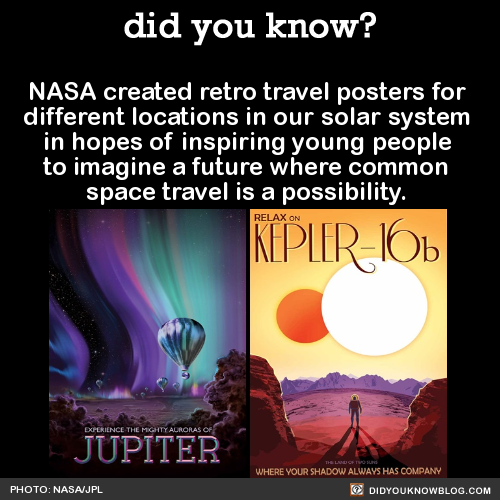Latest Posts by maevetheeuropan - Page 2

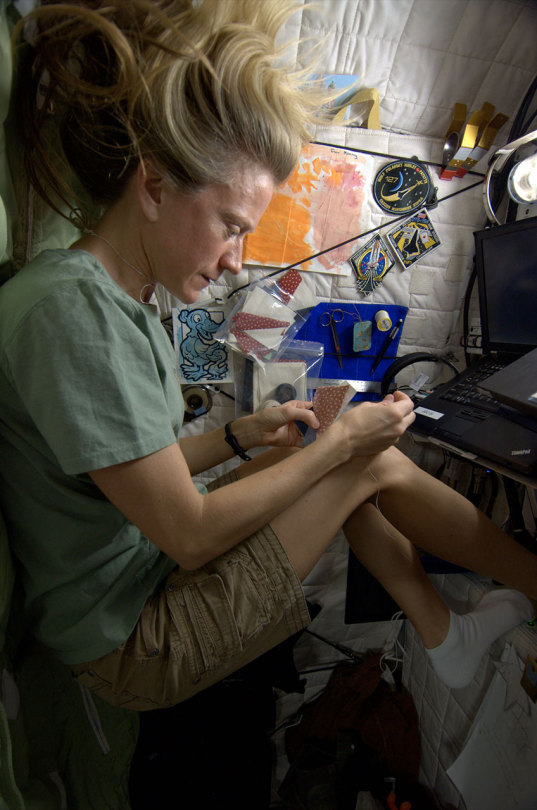
NASA astronaut Karen Nyberg is a self proclaimed crafter. A week ago she made a stuffed dinosaur from scraps on the space station. The little T-rex is made form the lining of Russian food containers and the toy is stuffed with scraps from an old T-shirt. While many toys have flown into space, this is the first produced in space.
Photos: Karen Nyberg, via CollectSpace

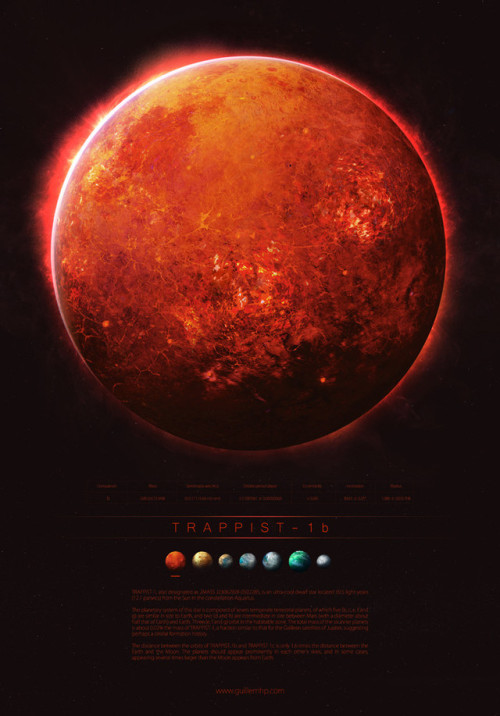
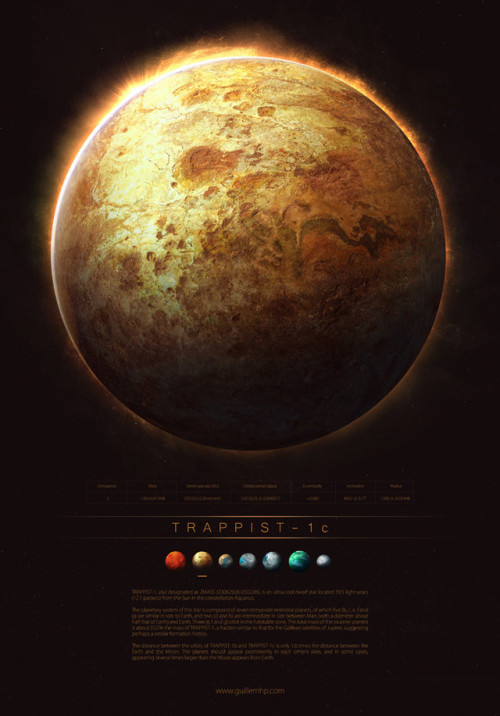
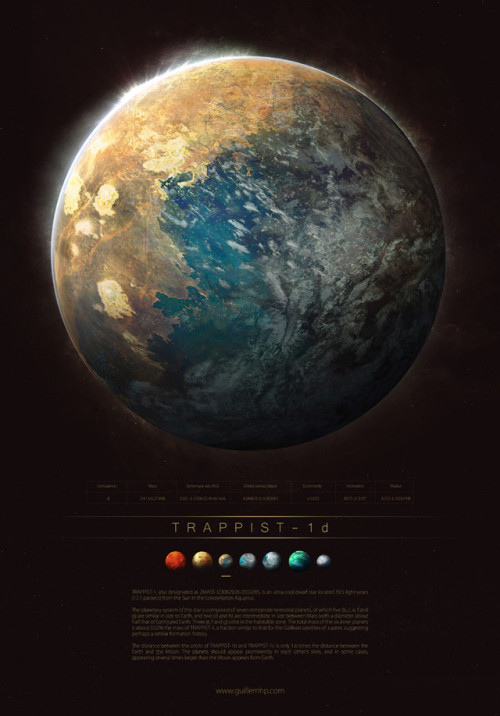
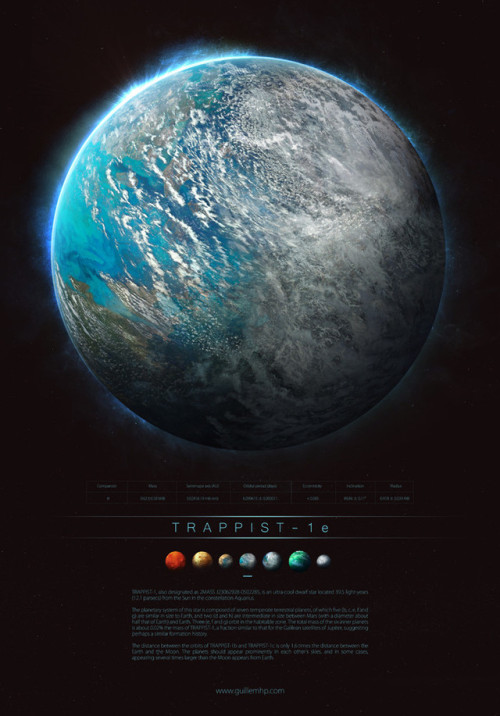
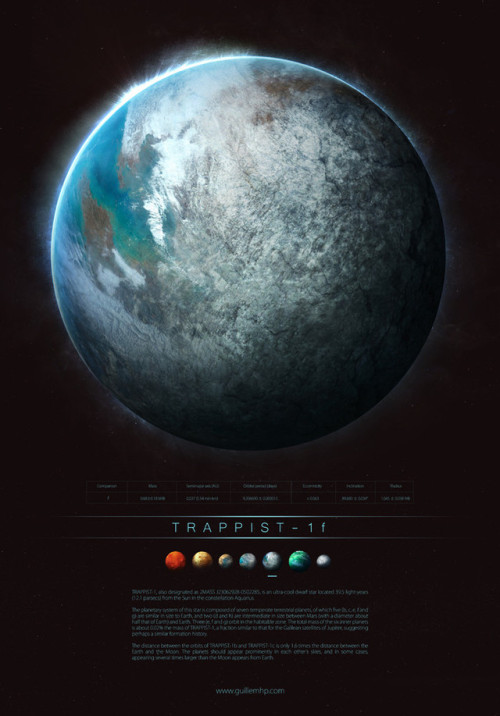

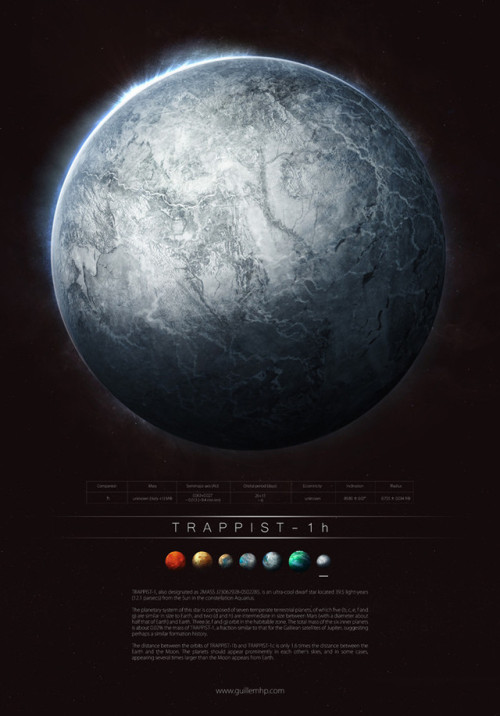
TRAPPIST - 1 by Guillem H. Pongiluppi

The Exoplanetary Menagerie
Today a massive discovery was announced: 39 light years away in the TRAPPIST-1 star system seven terrestrial planets all orbit extremely close to each other.
…and three are well within their star’s “habitable zone”.
TRAPPIST-1 is an ultra-cool dwarf star. Because its temperature is so much lower than a typical star like the sun (it’s roughly 2550 K while the sun’s 5772 K) planets are able to orbit much closer than they could in our Solar System and sustain habitable conditions. All seven of the discovered exoplanets orbit closer to TRAPPIST-1 than Mercury does to the sun.
Of the different planets discovered, one is immensely Earthlike, having a similar size and receiving roughly the same amount of light as Earth. This place could be a whole lot more like home than anything we’ve found yet. Another planet is a potential water-world, getting about as much light as does Mars (with an atmosphere, yes, it could be a liquid water world).
So close do these planets all orbit near to each other that if you were to go to one and look up, you could see the other planets in the sky above you… and they’d be as big as *or larger than the Moon is in our sky*. It must be one of the most beautiful sights.
So what’s the big deal right? NASA’s already found over 3000 exoplanets - what makes these ones special?
A few remarkable things:
One, TRAPPIST-1 is a member of the M-class stars - stars which make up 70% or so of all the stars out in the Milky Way. Knowing that such stars can host magnificent habitable planetary systems means the search for life just got blown wide open to 70% of the stars in our galaxy.
Two, though 39 light years seems far, this is actually unimaginably close. We’re basically neighbors. The fact that TRAPPIST-1 is so close means that astronomers will be able to subject this place to decades of intense research.
As NASA begins to turn space telescopes such as Hubble, Kepler and Spitzer on TRAPPIST-1, I think we’ll be hearing a lot more from it soon.
Before you go, please consider joining the Planetary Society. If TRAPPIST-1 intrigues you, just wait until you see what else we have happening.
At the Planetary Society we have a radio show with some of the most groundbreaking material to include exoplanet hunters, engineers designing interstellar missions and interviews with astronauts. Most important though, we go to D.C. and make sure the politicians continue funding NASA and space science, and we reach out to people and try to show them what could be.
On that note, here are some artist conceptions of the TRAPPIST-1 star system and what could be:





So good job to the team that made this discovery (especially lead author Michaël Gillon) and I can’t wait to learn more about this place soon.
(Image credit: NASA-JPL/Caltech, NASA/JPL-Caltech/R. Hurt (IPAC), NASA/JPL-Caltech/T. Pyle (IPAC), NASA/JPL-Caltech/R. Hurt (IPAC), ESO/M. Kornmesser and NASA-JPL/Caltech respectively)
Largest Batch of Earth-size, Habitable Zone Planets
Our Spitzer Space Telescope has revealed the first known system of seven Earth-size planets around a single star. Three of these planets are firmly located in an area called the habitable zone, where liquid water is most likely to exist on a rocky planet.

This exoplanet system is called TRAPPIST-1, named for The Transiting Planets and Planetesimals Small Telescope (TRAPPIST) in Chile. In May 2016, researchers using TRAPPIST announced they had discovered three planets in the system.

Assisted by several ground-based telescopes, Spitzer confirmed the existence of two of these planets and discovered five additional ones, increasing the number of known planets in the system to seven.

This is the FIRST time three terrestrial planets have been found in the habitable zone of a star, and this is the FIRST time we have been able to measure both the masses and the radius for habitable zone Earth-sized planets.
All of these seven planets could have liquid water, key to life as we know it, under the right atmospheric conditions, but the chances are highest with the three in the habitable zone.

At about 40 light-years (235 trillion miles) from Earth, the system of planets is relatively close to us, in the constellation Aquarius. Because they are located outside of our solar system, these planets are scientifically known as exoplanets. To clarify, exoplanets are planets outside our solar system that orbit a sun-like star.

In this animation, you can see the planets orbiting the star, with the green area representing the famous habitable zone, defined as the range of distance to the star for which an Earth-like planet is the most likely to harbor abundant liquid water on its surface. Planets e, f and g fall in the habitable zone of the star.
Using Spitzer data, the team precisely measured the sizes of the seven planets and developed first estimates of the masses of six of them. The mass of the seventh and farthest exoplanet has not yet been estimated.

For comparison…if our sun was the size of a basketball, the TRAPPIST-1 star would be the size of a golf ball.
Based on their densities, all of the TRAPPIST-1 planets are likely to be rocky. Further observations will not only help determine whether they are rich in water, but also possibly reveal whether any could have liquid water on their surfaces.
The sun at the center of this system is classified as an ultra-cool dwarf and is so cool that liquid water could survive on planets orbiting very close to it, closer than is possible on planets in our solar system. All seven of the TRAPPIST-1 planetary orbits are closer to their host star than Mercury is to our sun.

The planets also are very close to each other. How close? Well, if a person was standing on one of the planet’s surface, they could gaze up and potentially see geological features or clouds of neighboring worlds, which would sometimes appear larger than the moon in Earth’s sky.

The planets may also be tidally-locked to their star, which means the same side of the planet is always facing the star, therefore each side is either perpetual day or night. This could mean they have weather patterns totally unlike those on Earth, such as strong wind blowing from the day side to the night side, and extreme temperature changes.

Because most TRAPPIST-1 planets are likely to be rocky, and they are very close to one another, scientists view the Galilean moons of Jupiter – lo, Europa, Callisto, Ganymede – as good comparisons in our solar system. All of these moons are also tidally locked to Jupiter. The TRAPPIST-1 star is only slightly wider than Jupiter, yet much warmer.
How Did the Spitzer Space Telescope Detect this System?
Spitzer, an infrared telescope that trails Earth as it orbits the sun, was well-suited for studying TRAPPIST-1 because the star glows brightest in infrared light, whose wavelengths are longer than the eye can see. Spitzer is uniquely positioned in its orbit to observe enough crossing (aka transits) of the planets in front of the host star to reveal the complex architecture of the system.

Every time a planet passes by, or transits, a star, it blocks out some light. Spitzer measured the dips in light and based on how big the dip, you can determine the size of the planet. The timing of the transits tells you how long it takes for the planet to orbit the star.

The TRAPPIST-1 system provides one of the best opportunities in the next decade to study the atmospheres around Earth-size planets. Spitzer, Hubble and Kepler will help astronomers plan for follow-up studies using our upcoming James Webb Space Telescope, launching in 2018. With much greater sensitivity, Webb will be able to detect the chemical fingerprints of water, methane, oxygen, ozone and other components of a planet’s atmosphere.
At 40 light-years away, humans won’t be visiting this system in person anytime soon…that said…this poster can help us imagine what it would be like:

Make sure to follow us on Tumblr for your regular dose of space: http://nasa.tumblr.com
omfg I wanna buy this as a poster


Do not go gentle into that good night. Rage, rage against the dying of the light.



Two very alarming changes have already been made on the White House website. Reason, empathy and progress must be fought for. I hope this isn’t indicative of upcoming policies but fear it obviously is.
Also I just edited this post to add my own screenshot: the White House’s website for combating antibiotic resistant bacteria is gone too.
I want to note that most of the great steps of social progress in American history were *not* made by presidents or politicians acting of their own accord. America thrives in a state of constant *peaceful* revolt. Protest, political dissent and civil disobedience are what change things.
Voting is great and we need more to do it, but the women’s suffrage movement didn’t get voted into victory. Republican President Nixon (Nixon!) didn’t create the Environmental Protection Agency because he had an environmentalist’s stance on the Earth.
It’s important to always remember that when people wield their concerns and press power to answer for itself, they change the world.
(Images courtesy of screenshots from a friend and from myself)
Moral of the story:
Don’t fuck with the scientists and park rangers.
They largely consider themselves above politics.
The Republicans have awakened a sleeping giant.


For American science, the next four years look to be challenging. The newly inaugurated President Trump, and many of his Cabinet picks, have repeatedly cast doubt upon the reality of human-made climate change, questioned the repeatedly proven safety of vaccines. Since the inauguration, the administration has already frozen grants and contracts by the Environmental Protection Agency and gagged researchers at the US Department of Agriculture. Many scientists are asking themselves: What can I do?
And the answer from a newly formed group called 314 Action is: Get elected.

The organization, named after the first three digits of pi, is a political action committee that was created to support scientists in running for office. It’s the science version of Emily’s List, which focuses on pro-choice female candidates, or VoteVets, which backs war veterans. “A lot of scientists traditionally feel that science is above politics but we’re seeing that politics is not above getting involved in science,” says founder Shaughnessy Naughton.
“We’re losing, and the only way to stop that is to get more people with scientific backgrounds at the table.”
(Continue Reading)

This is hands down one of the most beautiful images I’ve ever seen. This is a visible-light image of Jupiter’s clouds from a mere 5000 km away.
What’s even more amazing is that this image was taken by JunoCam, NASA’s camera essentially being controlled by regular folks, not scientists. The public takes part in selecting targets to photograph, as well as having access to the raw data that comes back and you can even take the raw images that come back and process your own picture! Learn more about it all right here.
Thank you NASA!
(Image credit: NASA/JPL-Caltech/SwRI/MSSS/Gerald Eichstaedt/John Rogers)

From astrophysicist Katie Mack. I’m 100% behind her.
Unfollow me if you wish, but this blog will NEVER support Trump and instead supports the LGBT community, racial minorities, women, people with disabilities, immigrants, Muslims, Jewish people, and anyone else who is afraid now. I am with you, and this will always be a safe space for you.
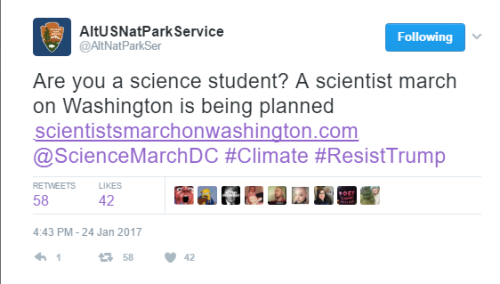
GUYS https://twitter.com/AltNatParkSer/status/824054953404669953 http://www.scientistsmarchonwashington.com/ THE NATIONAL PARK SERVICE IS IN OPEN REBELLION
Save Science
Not sure what to say. I’m actually legitimately nervous the Cheeto-in-Chief will demand a hold on the National Science Foundation grants like he did the EPA (disclaimer, the NSF is where my job comes from).
I feel so terrible for all the scientists and students who are now out of the job

Telescope Instruments Part One:
What they are (humor me)
Astronomy is an old field. For ages astronomers have had to be satisfied looking at the sky and interpreting what they saw as somehow connected to their Earthly lives. Zeus carried Ganymede off into the heavens and similarly the sky was a place of supernatural awe, somewhere that held your fortunes, a place the dead go, somewhere a child could be carried off to by a god.
Remarkable natural events like storms and lightning blistering over our us long seemed to confirm any and all suspicion and belief. For what could be responsible for something like lightning but a god? What else could the Sun be, but some divine light? Though the atoms in our bodies don’t remember where they come from, the answers have always been there, elusive.
When people finally started looking from the Sun to the stars in skeptical comparison, it was symbolically the beginning of a new age for astronomy. The stars weren’t pinholes in the sky, nor were they jewels (well some are “diamonds” but that was just a remarkably good guess!). Stars, people gradually realized, were kin to our own Sun. Could there be other Earths?
This truth is so grand, and it implies a universe so vast that it was more unbelievable to people than to simply go on assuming the lightning came from the likes of a “Zeus”. Human creativity, intellect and curiosity grew, however. We kept exploring and questioning until at last the technology we created harnessed the very electricity we used to fear.
In a sublime twist of irony Polyphemus, fire in hand, took to the heavens.
We have learned, in our exploration of nature, that we are not helpless. The divinity we saw in the heavens is literally same stuff that makes our blood red. We were of the sky all along and all it took was the most human part of us to figure this out: our curiosity.
Embracing our knack for exploration, however wasn’t exactly an easy truth. Our stories of gods in chariots dragging the Sun across the sky weren’t simply backwards: they were entirely simplistic. The universe astounded us for so long because our imaginations failed in grandiosity. The universe was the better magician and we simply didn’t know the tricks.
The technology which has resulted from our scientific exploration has similarly become more sophisticated. Out of necessity, we constantly invent new tools to solve old problems, which traditionally reveal another problem hitherto unknown.
The progression looks like this:
Astronomers stare up and wonder if the bright dot is a god or another planet.
Galileo invents the telescope and realizes that yes, there are other planets, but only a couple of the dots were visible - for most of them distance was too great to discern anything.
As math and science progressed, we became able to calculate the brightness, accounted for distance and it was obvious that all the bright dots unobservable with telescopes were roughly as bright as our Sun. Not all the dots fit this description though as some were very hazy and smoky looking.
Hubble then figures out that some of those hazy things are other galaxies, not just stars, but this extraordinary realization meant the universe was larger than the Milky Way! How could it be that another galaxy was all the way across space like that? Why did they seem to be moving farther from us faster, the farther they were?
I’ll stop there. You get the point. The progression of science has been met a proportional progression of mystery. This is as true today as it’s been since the dawn of science. The question then becomes this:
What is it that allows us to repeatedly push the darkness of ignorance away, to repeatedly domesticate the mysterious and turn the mystical forces of the universe to our personal use?
Our technology. Again, using our creativity and intellect as hammer and anvil, we forge miraculous solutions to unsolvable problems.
In astronomy, our resources are especially limited given the incredible distances that separate us from our targets. How can we possibly know anything about a planet orbiting a star hundreds of light years away?
In a way mother nature almost commit the perfect crime. It left one prolific clue behind though: light. Because of things like light’s dual wave-particle nature, techniques like spectroscopy and our growing ability to respond to and control our optics’ environments, astronomers are hot on multiple trails.
I want to explore and introduce you to some basic principles of the special mechanical eyes astronomers build which turn an otherwise invisible universe, into a bright, transparent scroll to our curiosity.
(Will be continued in part two)
(Image credit: NASA and Chris Gunn)


MERRY CHRISTMAS AND HAPPY HOLIDAYS FROM ME AND THE BOYS!

When Japan began to rebuild after the 2011 earthquake and tsunami, artist Manabu Ikeda started a massive pen & ink piece. He worked 10 hours a day, 6 days a week, for 3.5 years before finishing ‘Rebirth’, a 13x10 foot drawing of a tree rising from chaos and ruin. Source Source 2

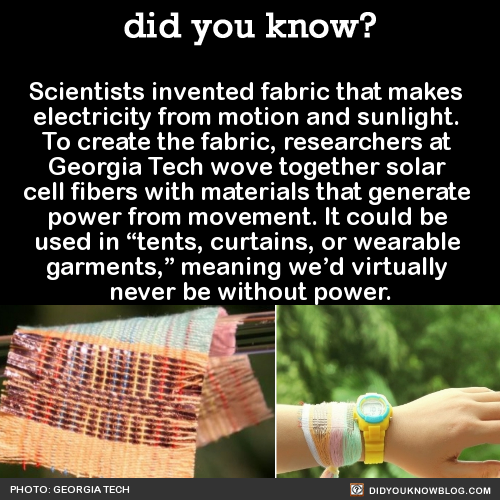
Scientists invented fabric that makes electricity from motion and sunlight. To create the fabric, researchers at Georgia Tech wove together solar cell fibers with materials that generate power from movement. It could be used in “tents, curtains, or wearable garments,” meaning we’d virtually never be without power. Source




Elevated Bus That Drives Above Traffic Jams



ExoMars Orbiter’s First Images
(Image credit: ESA/Roscosmos/ExoMars/CaSSIS/UniBE)
ooooo how awesome!

Prototype of Space Station’s Advanced Plant Habitat via NASA http://ift.tt/2fremIw

Ice is no match for CSU-developed coating
Anyone who’s ever chipped ice off a windshield or nervously watched a plane get de-iced, take note: Colorado State University researchers have invented an ice-repellent coating that out-performs today’s best de-icing products.
Researchers led by Arun Kota, assistant professor of mechanical engineering and biomedical engineering, have created an environmentally friendly, inexpensive, long-lasting coating that could keep everything from cars and ships to planes and power lines ice-free.
Their innovation, described in the Journal of Materials Chemistry, is a gel-based, soft coating made out of PDMS (polydimethylsiloxane), a silicone polymer gel with already widespread industrial use. Their experiments were supported by careful analysis of ice adhesion mechanics.
The performance measure of de-icing coatings is called ice adhesion strength - the shear stress necessary to remove ice from a surface - and is measured in kilopascals (kPa). Kota’s group demonstrated ice adhesion strength for their coating of about 5 kPa. By contrast, soft coatings available on the market have ice adhesion strength of about 40 kPa (lower is better). Other types of de-icing coatings made of rigid materials like Teflon typically perform at around 100 kPa.
Read more.
LOL oh @claraxbarton you know me SO well!
I’ve totally got the first ep on my DVR - I just haven’t had time to watch it lol
@maevemauvaise !!!!!!!!!!!!
Stories of Your Life is weeeeeiird
But good. Ted Chiang sort of feels like the new Borges - sort of.
(The film Arrival is based on one of the stories in this book)
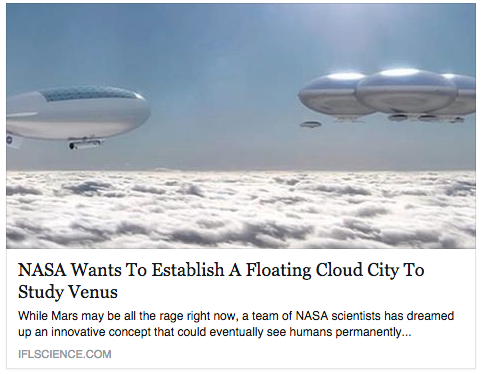
bioshock infinite is about to become reality
Everyone knows that, in space, no one can hear you scream. Sound is a wave that requires a medium to travel through, and if space is empty, there’s no medium to carry that sound. Except, as Mike from The Point Studios explains, empty is a relative term. Space is full of dust and gas and plasma, just not as full of that matter as we’re used to. Thus, the question of whether sound can travel through space turns into a matter of scale. If the scale–the wavelength–of a sound is much larger than the distance between molecules, then the sound can propagate. So there CAN be sound in space – it just has to have a very long wavelength and, thus, a very low frequency. Check out the video for the full story! (Video credit: The Point Studios)

pretty much
Kate Rubins’ Space Station Science Scrapbook
As a child, Kate Rubins dreamed of being an astronaut and a scientist. During the past four months aboard the International Space Station, that dream came full circle. She became the first person to sequence DNA in space, among other research during her recent mission, adding to her already impressive experience. She holds a doctorate in molecular biology, and previously led a lab of 14 researchers studying viruses, including Ebola.

Here’s a look back at Rubins in her element, conducting research aboard your orbiting laboratory.
Kate inside Destiny, the U.S. Laboratory Module
The U.S. national laboratory, called Destiny, is the primary research laboratory for U.S. payloads, supporting a wide range of experiments and studies contributing to health, safety, and quality of life for people all over the world.

Destiny houses the Microgravity Science Glovebox (MSG), in which Kate worked on the Heart Cells experiment.
Swabbing for Surface Samples
Microbes that can cause illness could present problems for current and future long duration space missions.

Understanding what microbe communities thrive in space habitats could help researchers design antimicrobial technology. Here, Kate is sampling various surfaces of the Kibo module for the Microbe-IV investigation.
Culturing Beating Heart Cells in Space
The Heart Cells investigation uses human skin cells that are induced to become stem cells, which can then differentiate into any type of cell.

Researchers forced the stem cells to grow into human heart cells, which Rubins cultured aboard the space station for one month.

Rubins described seeing the heart cells beat for the first time as “pretty amazing. First of all, there’s a few things that have made me gasp out loud up on board the [space] station. Seeing the planet was one of them, but I gotta say, getting these cells in focus and watching heart cells actually beat has been another pretty big one.”
Innovative Applied Research Experiment from Eli Lilly
The Hard to Wet Surfaces investigation from Eli Lilly, and sponsored by the Center for the Advancement of Science in Space (CASIS), looks at liquid-solid interactions and how certain pharmaceuticals dissolve, which may lead to more potent and effective medicines in space and on Earth.

Rubins set up vials into which she injected buffer solutions and then set up photography to track how tablets dissolved in the solution in microgravity.
Capturing Dragon
Rubins assisted in the capture of the SpaceX Dragon cargo spacecraft in July. The ninth SpaceX resupply mission delivered more than two thousand pounds of science to the space station.

Biological samples and additional research were returned on the Dragon spacecraft more than a month later.
Sliding Science Outside the Station
Science doesn’t just happen inside the space station. External Earth and space science hardware platforms are located at various places along the outside of the orbiting laboratory.

The Japanese Experiment Module airlock can be used to access the JEM Exposed Facility. Rubins installed the JEM ORU Transfer Interface (JOTI) on the JEM airlock sliding table used to install investigations on the exterior of the orbiting laboratory.
Installing Optical Diagnostic Instrument in the MSG
Rubins installed an optical diagnostic instrument in the Microgravity Science Glovebox (MSG) as part of the Selective Optical Diagnostics Instrument (SODI-DCMIX) investigation. Molecules in fluids and gases constantly move and collide.

When temperature differences cause that movement, called the Soret effect, scientists can track it by measuring changes in the temperature and movement of mass in the absence of gravity. Because the Soret effect occurs in underground oil reservoirs, the results of this investigation could help us better understand such reservoirs.
The Sequencing of DNA in Space
When Rubins’ expedition began, DNA had never been sequenced in space. Within just a few weeks, she and the Biomolecule Sequencer team had sequenced their one billionth “base” – the unit of DNA - aboard the orbiting laboratory.

The Biomolecule Sequencer investigation seeks to demonstrate that DNA sequencing in microgravity is possible, and adds to the suite of genomics capabilities aboard the space station.
Studying Fluidic Dynamics with SPHERES
The SPHERES-Slosh investigation examines the way liquids move inside containers in a microgravity environment. The phenomena and mechanics associated with such liquid movement are still not well understood and are very different than our common experiences with a cup of coffee on Earth.

Rockets deliver satellites to space using liquid fuels as a power source, and this investigation plans to improve our understanding of how propellants within rockets behave in order to increase the safety and efficiency of future vehicle designs. Rubins conducted a series of SPHERES-Slosh runs during her mission.
Retrieving Science Samples for Their Return to Earth
Precious science samples like blood, urine and saliva are collected from crew members throughout their missions aboard the orbiting laboratory.

They are stored in the Minus Eighty-Degree Laboratory Freezer for ISS (MELFI) until they are ready to return to Earth aboard a Soyuz or SpaceX Dragon vehicle.
Measuring Gene Expression of Biological Specimens in Space
Our WetLab-2 hardware system is bringing to the space station the technology to measure gene expression of biological specimens in space, and to transmit the results to researchers on Earth at the speed of light.

Rubins ran several WetLab-2 RNA SmartCycler sessions during her mission.
Studying the First Expandable Habitat Module on the Space Station
The Bigelow Expandable Activity Module (BEAM) is the first expandable habitat to be installed on the space station. It was expanded on May 28, 2016.

Expandable habitats are designed to take up less room on a spacecraft, but provide greater volume for living and working in space once expanded. Rubins conducted several evaluations inside BEAM, including air and surface sampling.
Better Breathing in Space and Back on Earth
Airway Monitoring, an investigation from ESA (the European Space Agency), uses the U.S. airlock as a hypobaric facility for performing science. Utilizing the U.S. airlock allows unique opportunities for the study of gravity, ambient pressure interactions, and their effect on the human body.

This investigation studies the occurrence and indicators of airway inflammation in crew members, using ultra-sensitive gas analyzers to evaluate exhaled air. This could not only help in spaceflight diagnostics, but that also hold applications on earth within diagnostics of similar conditions, for example monitoring of asthma.
Hot Science with Cool Flames
Fire behaves differently in space, where buoyant forces are removed. Studying combustion in microgravity can increase scientists’ fundamental understanding of the process, which could lead to improvement of fire detection and suppression systems in space and on Earth.

Many combustion experiments are performed in the Combustion Integration Rack (CIR) aboard the space station. Rubins replaced two Multi-user Droplet Combustion Apparatus (MDCA) Igniter Tips as part of the CIR igniter replacement operations.
Though Rubins is back on Earth, science aboard the space station continues, and innovative investigations that seek to benefit humans on Earth and further our exploration of the solar system are ongoing. Follow @ISS_Research to keep up with the science happening aboard your orbiting laboratory.
Make sure to follow us on Tumblr for your regular dose of space: http://nasa.tumblr.com
